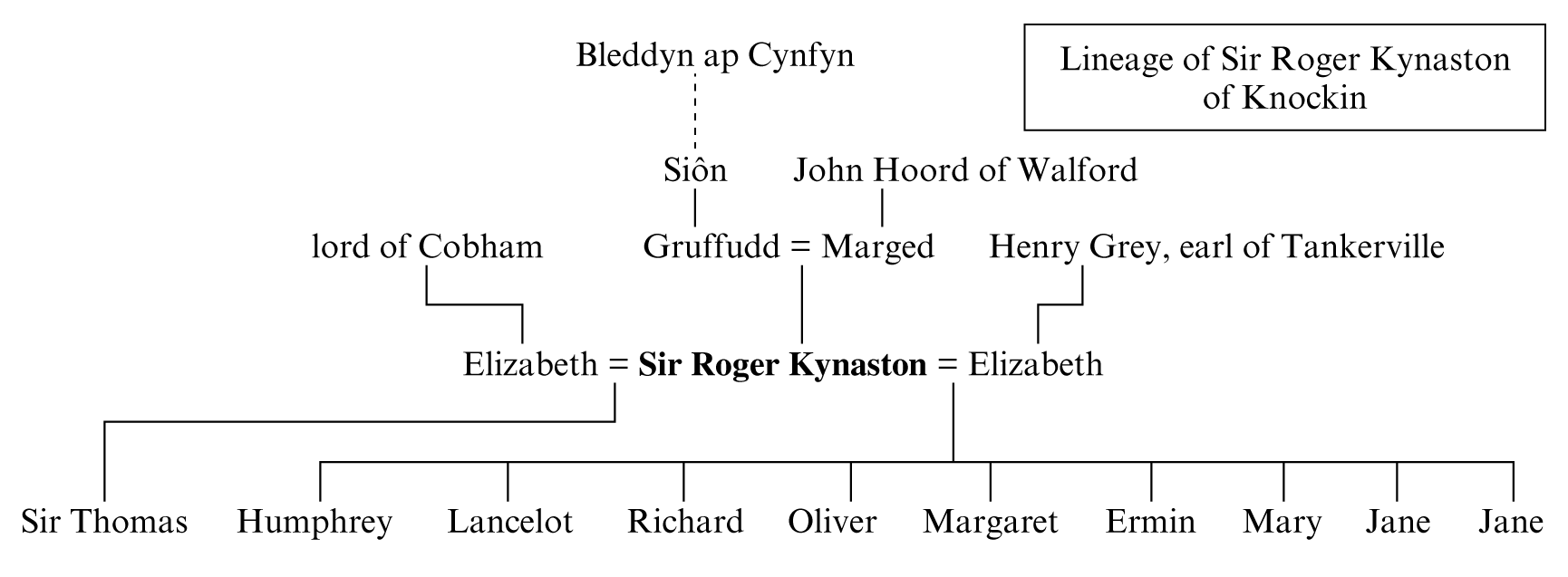Sir Roger Kynaston ap Gruffudd of Knockin was the patron of poem 79, in which he is praised. Lewys Glyn Cothi composed the only other surviving poem for Roger, which is the earliest poem for a Kynaston, namely a poem to request a suit of armour from both Roger and his second wife, Elizabeth daughter of Henry Grey, on behalf of Edward ap Dafydd of Erbistock (GLGC poem 207). Poems survive for two of Roger’s children: namely a praise poem by Tudur Penllyn for Mary, Sir Roger Kynaston’s daughter, and her husband, Hywel ap Siancyn of Ynysymaengwyn (GTP poem 6), and a poem by Gutun Owain to request a buckler from Gruffudd ap Hywel on behalf of Humphrey (or Wmffre) ap Sir Roger Kynaston (GO poem XV). Roger’s descendants and other Kynastons were praised by numerous poets: Gruffudd Hiraethog, Huw Arwystl, Rhys Cain, Lewys Powys, Wiliam Llŷn, Ieuan Llafar and Edward Maelor.
Lineage
The genealogical table below is based on WG1 ‘Bleddyn ap Cynfyn’ 1, 37, 38; WG2 ‘Bleddyn ap Cynfyn’ 38 A1, A3.

Lineage of Sir Roger Kynaston of Knockin
Roger had brothers and sisters, namely Jenkin, Phillip, William, Lucy and Ann. Roger’s children had numerous marital connections with many of Guto’s patrons, too many, indeed, to be shown in a genealogical table. Humphrey’s first wife was Elizabeth daughter of Maredudd ap Hywel of Oswestry, and his second wife was Margaret daughter of Wiliam ap Gruffudd of Cochwillan. Margaret (Roger’s daughter) married Richard ap Gruffudd Hanmer, nephew of Siôn Hanmer ap Siôn Hanmer of Halghton and Llai. Ermin’s husband, Siôn Eutun, was a great-grandson of Siôn Eutun ap Siâms Eutun of Parc Eutun. Mary’s first husband, Hywel ap Siancyn of Ynysymaengwyn, was descended from the family of Cryniarth, and her father-in-law, Siancyn ab Iorwerth, was a nephew of Ieuan ab Einion. Furthermore, Mary also had a relationship with Sir Rhys ap Tomas of Abermarlais. And lastly, one of the two Janes married Ieuan, son of Dafydd Llwyd ap Gruffudd of Abertanad.
His career
Roger took his surname from the town of Kynaston in the parish of Kinnerley in Shropshire, and he is associated with the nearby village of Knockin and Hordley further to the north. He shone as an administrator and soldier and was a supporter of the Yorkists during the Wars of the Roses. He was constable of Denbigh in 1454 and constable of Harlech in 1473 (Evans 1995: 63, 163). He fought at the battle of Blore Heath in 1459, where he slew Lord Audley, and then at the battle of Ludford in the same year, and Edward IV placed great trust in him (Evans 1995: 62–4; Ebrington 1979: 75). From 1461 to 1463 he was sheriff of Shropshire, being the first person appointed by Edward to that post (Ebrington 1979: 75). On 28 August 1467 he was summoned before the king and William Herbert was amongst those charged with his arrest, yet the exact circumstances are unclear (CPR). By 1473 he was made sheriff of Merionethshire for life (Evans 1995: 163). In 1471, as related in Guto’s poem, Roger fought at the battle of Barnet (14 April) and then at the battle of Tewkesbury (4 May), where it is said he slew the earl of Warwick (79.49n). On the second occasion he was also knighted on the field of battle. Guto’s poem confirms entirely what is know of him from other sources, especially his military ability and the obvious trust that existed between him and Edward IV. He died in 1495/6.
Bibliography
Ebrington, C.R. (1979) (ed.), A History of Shropshire, vol. iii (Oxford)
Evans, H.T. (1995), Wales and the Wars of the Roses (second ed., Stroud)





